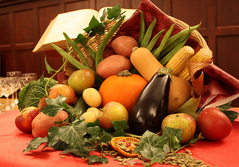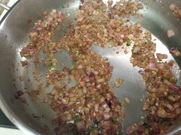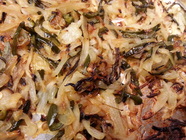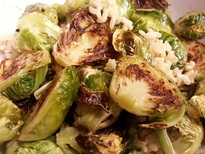
However, you may still want to enjoy some of your favorite old traditions, other than the turkey, without using any animal-based foods. Here are some suggestions:
1. Stuffing. If you use butter to prepare your stuffing, substitute olive oil or Earth Balance (vegan butter) and add nuts or seeds such as pecans, walnuts, or pumpkin seeds. Roast the stuffing inside of red bell peppers. The juices from the red bell peppers will bake into the stuffing, adding even more flavor.
2. Mashed Potatoes. Rather than use butter and cream, try substituting Earth Balance (vegan butter) and a non-dairy milk such as almond milk or coconut milk.
For something even richer, try braising a head of whole garlic cloves (separate the cloves) and a large onion, cubed, in 2-3 cups of vegetable broth with a couple of fresh sprigs of rosemary or thyme at 400 °F until the garlic and onion have just caramelized and most of the liquid has evaporated, about 35-40 minutes.
Add the caramelized garlic and onion to a high-speed blender, along with 1 ½ cup of raw cashews that were soaked for 3-4 hours, then drained, and about ¼ cup of unsweetened almond milk and blend into a smooth paste that can be added and mashed into cooked potatoes to make incredible garlic-mashed potatoes!
3. Gravy. Even if you’re not having any turkey, you still may want to have gravy to put over your potatoes and stuffing! It’s easy to make a gravy without using the drippings.
Start by dicing and caramelizing an onion, then add 4-8 ounces of sliced or diced mushrooms and a clove of garlic, minced or pressed, and sauté until the mushrooms are soft (add water or vegetable broth as needed, about a tablespoon at a time, to prevent the mushrooms and garlic from sticking or burning).
Stir in about a half teaspoon each of thyme and sage, and then add a tablespoon of flour and continue to stir until smooth (the flour will thicken).
Slowly add a cup of vegetable broth, a little at a time, stirring constantly as you dilute the flour/mushroom mixture to prevent any lumps from forming.
Once all the liquid has been added, bring it to a boil, stirring constantly until the gravy thickens, about 3-5 minutes. Add sea salt and fresh ground pepper to taste.
You can serve the gravy as is with pieces of onion and mushrooms, or use an immersion blender to puree the onion and mushrooms into a deliciously smooth gravy.
4. Sweet Potatoes and Yams. The culprits in most of these recipes typically include butter, milk or cream, eggs, and/or marshmallows. You can substitute vegan butter such as Earth Balance and a non-dairy milk such as almond milk. You can also substitute coconut milk for the cream.
If the recipe calls for egg and the sweet potatoes or yams are whipped, the egg is used to help firm up the casserole. You can use 2-4 tablespoons of cornstarch in place of the egg and get the same effect without any cholesterol.
If your recipe calls for marshmallows, you may not be aware that they are made with gelatin and sometimes eggs, both animal-based foods. Most health food stores such as Whole Foods carry vegan marshmallows that are made with plant-based gelling agents such as agar and no eggs.
5. Pumpkin Pie. If your pumpkin pie recipe calls for evaporated milk or heavy cream, and eggs, you can substitute 12 ounces of silken tofu for the milk or cream, and ¼ cup of cornstarch for the eggs.
The silken tofu will add a creamy texture along with protein and calcium, and the cornstarch will help the pie firm up.
Bake the pie for 40-45 minutes until the crust is browned and the outermost inch of the pie is firm. The rest will firm up as the pie cools.
Those are my tips. What are some of your favorite Thanksgiving dishes?
Happy Thanksgiving!






 RSS Feed
RSS Feed